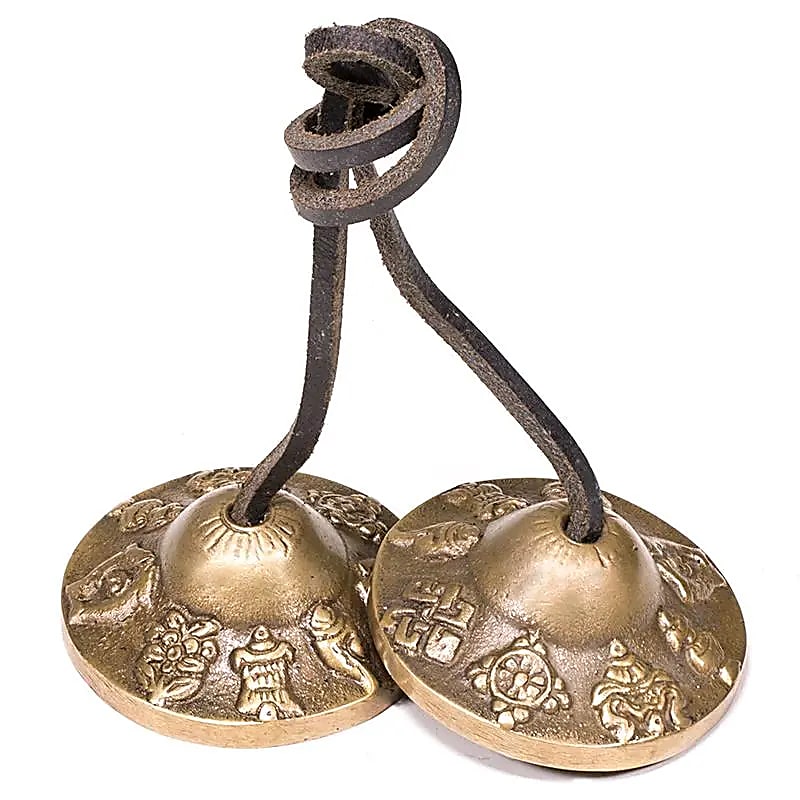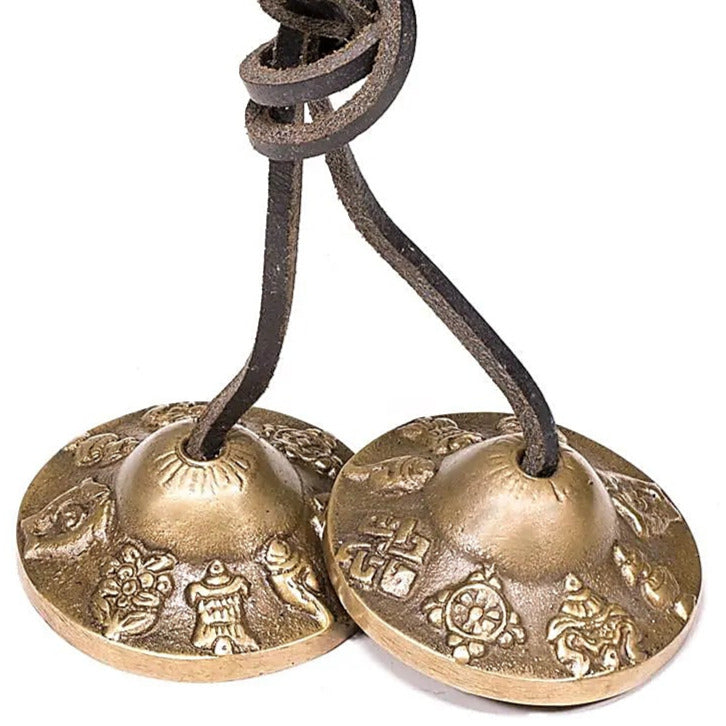Tibetan Tingsha cymbal, engraved with Buddhist auspicious symbols, 3 sizes to choose from from 5.5 to 7.5 cm. Used as musical offerings!
Tibetan Tingsha cymbal, engraved with Buddhist auspicious symbols, 3 sizes to choose from from 5.5 to 7.5 cm. Used as musical offerings!
Couldn't load pickup availability
- ✧─────✧
About the product:
→ Tibetan Cymbal - Tingsha - Ding-Sha's
🌍 Origin: Nepal - Tibet - Bhutan - China
📐 Dimensions/ ⚖️ Weight:
- Reference 19138 = 5.5 centimeters - +/- 174 grams
- Reference 19139 = 6.5 centimeters = +/- 240 grams
- Reference 19140 = 7.5 centimeters = +/- 320 grams
🧬 Materials: Copper + Bronze
📦 Packaging: Per pair
🎁 Ideal for giving as a gift or treating yourself!
🏷️ Option: If you want covers in typical Nepalese brocade: Click here
→ See all Tingsha models: Click here
🎶 An Asian percussion instrument often used by dancers including belly dancers.
They are small without any specific tone.
They are usually attached to the thumb and middle finger of one or both hands and struck together in a specific rhythm that usually accompanies other instruments.
These cymbals are an excellent instrument for developing a sense of rhythm, and/or improving it in children and adults. They are mainly used in sets of 2 at a time, one for each hand.
🌸 The 8 Auspicious Buddhist Symbols
1. The Parasol (chatra)
Symbol of spiritual protection.
Represents the coolness of the shadow that shelters suffering.
2. The Two Golden Fishes (suvarnamatsya)
Symbol of freedom and happiness.
Represents emancipation from the ocean of suffering and the ability to swim freely towards enlightenment.
3. The Conch (shankha)
Symbol of sacred sound and Dharma teaching.
Evokes the spread of truth and the victory of wisdom.
4. The Endless Knot (shrivatsa)
Symbol of unity, interconnection and harmony.
Represents the union of wisdom and compassion.
5. The Victory Banner (dhvaja)
Symbol of the triumph of good over evil.
Evokes the victory of Dharma over ignorance.
6.The Wheel of Dharma (dharmachakra)
Symbol of Buddhist teaching.
Its eight spokes represent the Noble Eightfold Path to enlightenment.
7. The Lotus (padma)
Symbol of purity and spiritual awakening.
The lotus is born from mud but rises pure and luminous, an image of wisdom born from suffering.
8. The Treasure Vase (kalasha)
Symbol of prosperity and long life.
Represents the abundance of spiritual teachings and blessings.
📋 Fact sheet:
| Property | Details |
|---|
| Name | Tingsha (ཏིང་ཤ་) – Tibetan cymbals |
| Nature | Buddhist ritual and musical object |
| Composition | Traditional alloy of metals (bronze, copper, brass, sometimes silver) |
| Appearance | Two small cymbals connected by a rope or leather strap |
| Origin / Use | Tibet, Nepal, India; used in Buddhism and shamanic rituals |
| Sound | Clear, crystalline and prolonged sound, considered to be purifying |
| Virtues / Symbolism | - Purification of negative energies 🔔 - Promotes meditation and concentration - Energy harmonization tool |
| Spiritual Use | - Opening/closing rituals - Support for meditation and yoga - Energy cleaning of places and stones |
| Purification | Not intended as a stone, but used to purify |
| Recharging | Not applicable (ritual object) |
| Value | Varies depending on age, alloy, size and ornamentation |
| Short story / Anecdote | Tingsha are often decorated with Buddhist symbols (8 auspicious signs). Their sound is said to represent the primordial vibration that connects the material and spiritual worlds. |
- ✧─────✧
A question? A comment? | Order and delivery information
A question? A comment? | Order and delivery information
⋯⋯⋯⋯⋯⋯⋯⋯⋯⋯⋯⋯⋯⋯⋯⋯⋯⋯⋯⋯
📞 Customer service available from Tuesday to Saturday , from 10am to 7pm (French time)
- 🇫🇷 From France: 06 51 85 38 18
- 🌍 From abroad: +33 6 51 85 38 18
- 💬 Live chat: via the bubble in the bottom right corner of your screen
- 📧 Email : available 24/7 – we respond quickly!
⋯⋯⋯⋯⋯⋯⋯⋯⋯⋯⋯⋯⋯⋯⋯⋯⋯⋯⋯⋯
🔖 Order today and receive your package within 2 to 10 days depending on your continent.
💳 Secure payment & certified by SSL encryption 🔐
↩️ Returns & exchanges possible within 14 to 30 days after receipt.
🌍 Shipping costs are calculated automatically based on your shipping address at checkout.
📦 Country of shipment: France 🇫🇷
Share





